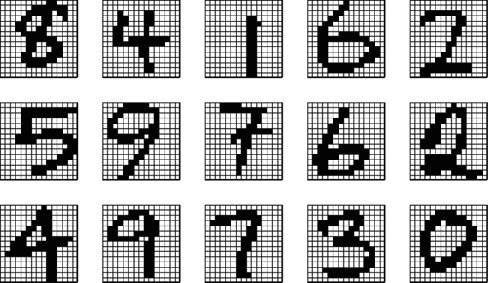1 FUNDAMENTALS OF PATTERN RECOGNITION
1.1 BASIC CONCEPTS: CLASS, FEATURE, DATA SET
A wealth of literature in the 1960s and 1970s laid the grounds for modern pattern recognition [386; 106; 141; 340; 282; 305; 353; 290; 90; 140]. Faced with the formidable challenges of real-life problems, elegant theories still coexist with ad hoc ideas, intuition, and guessing.
Pattern recognition is about assigning labels to objects. Objects are described by features, also called attributes. A classic example is recognition of handwritten digits for the purpose of automatic mail sorting. Figure 1.1 shows a small data sample. Each 15×15 image is one object. Its class label is the digit it represents, and the features can be extracted from the binary matrix of pixels.

FIGURE 1.1 Example of images of handwritten digits.
1.1.1 Classes and Class Labels
Intuitively, a class contains similar objects, whereas objects from different classes are dissimilar. Some classes have a clear-cut meaning, and in the simplest case are mutually exclusive. For example, in signature verification, the signature is either genuine or forged. The true class is one of the two, regardless of what we might deduce from the observation of a particular signature. In other problems, classes might be difficult to define, for example, the classes of left-handed and right-handed people or ordered categories such as “low risk,” ...
Get Combining Pattern Classifiers: Methods and Algorithms, 2nd Edition now with the O’Reilly learning platform.
O’Reilly members experience books, live events, courses curated by job role, and more from O’Reilly and nearly 200 top publishers.

